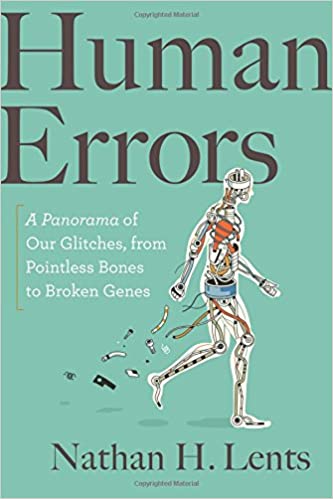 |
Human Errors A Panorama of Our Glitches, from Pointless Bones to Broken Genes
Nathan H. Lents
Houghton Mifflin Harcourt, 2018
ISBN: 9781328974693 |
It is true that biological systems are riddled with absurd structures that defy logic (what the author calls "glitches"), and at first glance this book promises to elaborate on some of these. But what quickly becomes apparent is that it treats "glitches" (unnecessary or inadequate structures) and "limitations" (the boundaries within which a biological system is meant to operate) as interchangeable. And the difference between these, although subtle, is significant. In my view it is unfair to state that a biological entity "fails" or is "imperfect" when pushed to its limits and then state that this is a glitch. After all, would we say that an iron has a glitch because it doesn't toast bread "just right"? Even more irritating is the fact that the author clearly knows the difference between glitches and limitations, but nevertheless seems to confuse them. For instance, in Chapter 5 ("Why God Invented Doctors"), he treats the development of cancer as a glitch, when in reality it is a limitation baked into the equation of life. It is impossible to imagine DNA containing cells (present in all life forms on earth) copying themselves without introducing occasional mistakes in the DNA code (the basis of cancer). Perfect systems simply don't exist anywhere. Similarly, in chapter 6 ("A Species of Suckers") he argues that a glitch in the human brain allows teenagers to participate in risky behaviors. And yes, although the explanation that this is due to advertising their fitness is reasonable, the author completely overlooks the fact that the prefrontal cortex (which is the great moderator of complex behavior) does not fully mature until well into the third decade of life. That is not an indication of an imperfect brain, but a limitation. We simply can't ask an immature brain to produce mature behaviors. After all, there is a reason why parenting does not end at adolescence.
To add insult to injury, there are also plenty of instances where the proposed glitches are discussed too superficially, potentially misleading the reader. For example, in Chapter 3 ("Junk in the Genome"), non-coding DNA is treated as junk, which is a somewhat outdated idea. The author minimizes the fact that what we used to call junk is actually turning out to have important functions. The discovery of microRNA's in the last two decades come to mind as a glaring example. Why should we assume that the rest of the "junk DNA" is not useful in as-of-yet unknown ways? At the very least, if we truly have junk (for instance the remnants of viruses in our genome), we still need to consider that it might serve as "filler" to separate coding DNA appropriately. There is plenty of evidence that the relative location and distance between genes within a chromosome is critical for their correct functioning. In this sense, the filler DNA would have an important role, and therefore would not be a glitch. Indeed, would not natural selection keep weeding out real junk DNA through random chromosomal deletions if it truly were useless? Smaller, more compact chromosomes are definitely more efficient and less prone to damage. I could go on, but I think the point is made.
Last, and perhaps ironically, readers should be aware that there are glaring factual errors within the book. Two that come to mind are: 1) "microscopic roundworms... have no real tissues or organs" (pg 68; readers and author alike should visit www.wormbase.org and www.wormbook.org for an overview), and 2) "even the most unimaginative engineer would have ...at the very least put cilia on the walls of the fallopian tubes..." (pg 116; they actually are ciliated as reviewing any anatomy textbook would confirm).
In conclusion, although the right intention was there to create a fun and informative book, in the end we get a somewhat superficial, flawed and sensationalistic account of the human body's "imperfections". The naive reader is advised to look elsewhere as this book will provide a biased and incomplete account of those evolutionary quirks. Sorry.
